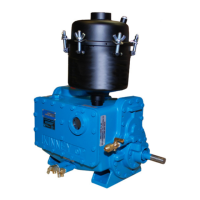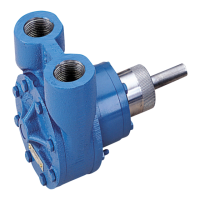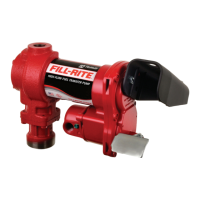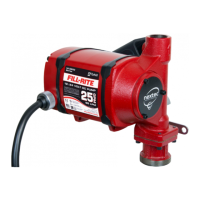19
Manual 1808 Rev B p/n 001808 0000
09
TROUBLESHOOTING
STARTING TROUBLES OR
STALLING
Pump starting troubles or stalling may be due
to loose or broken belts, lack of lubrication,
obstruction inside the pump, temperature too low,
the pump ooded with oil, locked drive bearing, or
lack of electrical power. If the problem is loose or
broken belts, see V-Belts on page 14. If stalling
is due to insufcient lubrication, this can be due to
blocked oil lines, malfunction of the solenoid valve,
or low oil level. If the oil supply is depleted, it is
probably caused by a ruptured oil line. If the pump
is not free to turn by hand, dismantle it to remove
the obstruction. If the pump is ooded, turn the
pump over by hand before energizing to force the
oil out into the separator. If the pump is too cold
to start, use an immersion heater in the oil, or live
steam on the exterior of the pump, until the oil is
warmed to a temperature of 40°F (4°C) minimum.
If there is no electrical power to the motor, check
the fuses or relays for signs of overloading.
CHECKING PUMP PERFORMANCE
If the processing time increases or the ultimate
pressure becomes poor with no recent changes
in the process or in system conguration, test the
pump to determine if the trouble is in the pump
or the connected process equipment. To check
the condition of the pump, measure the blank-off
pressure using a McLeod gauge and, if available,
take a thermistor or thermocouple gauge reading.
See Table 9-1 on page 23 for a listing of
common symptoms in the system.
Average blank-off readings are 5 to 25 microns
with a McLeod gauge and 10 to 100 microns with a
thermocouple gauge. The specication pressure is
10 microns (10 x 10 3 Torr) McLeod gauge reading.
To obtain a blank-off reading, isolate the pump
from the process equipment. Connect a vacuum
gauge to the pump side of the isolation valve (see
Figure 5-2 on page 10) and operate the pump
to allow it to attain the lowest pressure.
If the McLeod gauge reading is low and the
thermocouple gauge reading is high, the pump
oil is contaminated. Change the oil and check
the blank-off pressure again. Additional oil
changes may be necessary to ush all traces of
contamination from the pump. After eliminating oil
contamination as a possible cause of poor pump
performance, recheck the blank-off pressure.
If both the McLeod and thermocouple gauge
readings are high, this indicates that the pump is
leaking. Proceed as directed in Pump Leaks on
page 20.
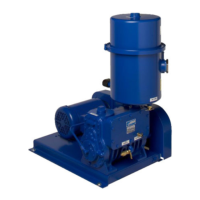
